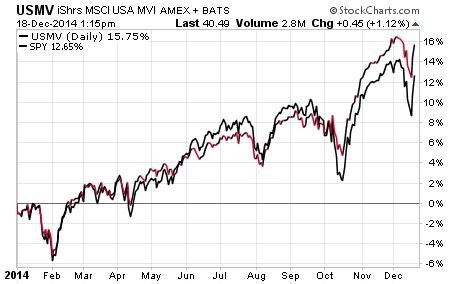2014 has been marked by interesting dynamics that include a crash in commodities, sliding interest rates and another bullish year for stocks. With so many questions surrounding the fate of the markets, investors that have embraced a low volatility mindset have been rewarded for their conservatism.
iShares MSCI USA Minimum Volatility ETF
The iShares Trust USMV tracks approximately 160 large-cap companies from a broad pool of publicly traded equities. The goal is to produce a diversified basket of high quality stocks with fewer price fluctuations than a traditional market-cap focused index.
With 2014 almost in the books, USMV has added a moderate 3 percent performance gain over the SPDR S&P 500 ETF Trust SPY since the beginning of the year. The chart below shows how this low volatility index also had far less draw down in the October sell off as well.

USMV benefits from having its largest sector allocation to healthcare, which proved to be one of the strongest areas of the market this year. Financials and technology round out the top three rankings for this ETF.
While low volatility strategies certainly added value in domestic markets, international funds proved to be a hit as well.
iShares MSCI EAFE ETF
The iShares MSCI EAFE Index Fund (ETF) EFA is the third-largest ETF in the world and biggest international offering with $51 billion in assets. EFA has fallen more than 8 percent so far this year as European worries weighed on the 900+ stocks this index.
iShares MSCI EAFE Minimum Volatility ETF
By contrast, the iShares MSCI EAFE Minimum Volatility ETF EFAV tracks a narrower subset of 200 companies and has gained less than 1 percent in 2014.
iShares MSCI Emerging Markets ETF
Lastly, the iShares MSCI Emerging Markets Indx (ETF) EEM tracks over 800 stocks of emerging market countries and has fallen nearly 7 percent this year. That loss would have been somewhat mitigated through the iShares MSCI Emerging Markets Minimum Volatility ETF EEMV, which has slipped 4 percent in 2014.
EEMV has outsized exposure to China, Taiwan and South Korea, which have helped cushion the shock of volatile countries such as Russia and Brazil. Additionally, EEMV has an expense ratio of just 0.25 percent compared to 0.67 percent for EEM.
While low volatility strategies face the potential of underwhelming returns in a rapidly rising stock environment, they have proven to be worthy holdings for investors this year.
© 2025 Benzinga.com. Benzinga does not provide investment advice. All rights reserved.
Trade confidently with insights and alerts from analyst ratings, free reports and breaking news that affects the stocks you care about.